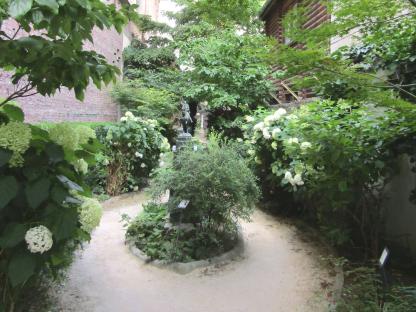Inner Garden
Architecture
By the end of the arcade, a former paved driveway leads to the heart of the museum, the old artists’ residence built in the late 19th century. Around the garden, several buildings with half-timbered brick façades, reinforced with iron rods, were built progressively.
In 1878, the carpenter Pierre Auguste Paillard built the first two-storey building meant to house six artist’s studios, equipped with a mezzanine and high north-facing windows providing a generous and constant flood of sunlight. Meant for painters or engravers, the upstairs rooms were initially served by simple loft ladders.
Bourdelle in 1885 rented his first studio on the ground floor at the end of the courtyard – the current techniques room. He then took over what is now the sculpture studio of the museum. In 1900, he started renting the studio above, turned today into the café-restaurant.
In 1881, Paillard built another one-storey building on the other side of the courtyard, where he arranged four new studios. The sunlight there comes from zenithal glass roofs and windows pierced in the northern walls. Over the courtyard, the zinc sloping roof ends with an awning adorned with carved fascia boards, reminiscent of resort architecture. In front of the building, a Doric colonnade – probable remnant of a burned down Parisian building – hints at the classical education of the tenants.
As soon as 1896, Bourdelle started renting a studio there, corresponding to the current room 3. He progressively took over all the other studios during the interwar period. These workshops were turned into exhibition rooms in 1938, when his widow, Cléopâtre, opened the place to the public, even prior to the museum’s creation.
Plant varieties
On the threshold leading to the second garden, Sappho is meditating under the goldenrain tree, bedecked in June with golden plumes. The paulownia unfolds its huge plump leaves above the bench. The little Faun disappears between the blue ears of veronica, the crosiers of ferns, and the ground-cover geraniums. Following the wintry whiteness of the Corsican hellebore, the Japanese quince and the intoxicatingly fragrant daphne ‘Aureomarginata’ start blooming as early as February. Under the branches of the ‘Iceberg’ climbing rose, a wing-footed Young Love joins the round dance of the hydrangeas in summer and of the Japanese anemones in autumn. The partial shade of the thicket around Dying Centaur is perfect for the precocious flowers of camelia, magnolia stellata, and prunus 'Hally Jolivette'. Beneath the cornelian cherry dogwood, bearing wild and tart fruits, Wilson’s honeysuckle intertwines with the glazed leaves of sarcococca, the red bells of fuchsia, and the rosy panicles of hydrangeas. The long inflorescences of the hydrangea aspera 'Bellevue' take on wine-red hues, by the end of the season. Patinated over the years, the trunk of the black locust, or false acacia, matches the Virgin with Offering, bringing Heaven and Earth together.
Following of the visit

don't miss any news from the Bourdelle Museum.
Subscribe to our monthly newsletter









